|
Limitar tu búsqueda
[+–] Creator
- Aguayo Tellez, Ernesto (1)
- Aguilera, Nelly (2)
- Amuedo Dorantes, Catalina (1)
- Ayala Gaitán, Edgardo A. (1)
- Benavides, Guillermo (1)
- Blair, Randall (1)
- Calderón-Madrid, Angel (1)
- Camillo Rosati, Furio (1)
- Campos Vázquez, Raymundo M. (1)
- Campuzano, Larissa (1)
- Castellanos, Sara G. (1)
- Coello Levet, Carlo G. (1)
- Cruz Rivero, Carlos (1)
- Cuilty, Emilio (1)
- De la Torre, Rodolfo (2)
- Gameren, Edwin van (1)
- García Moreno, Vicente (1)
- Heimann, Ursula (1)
- Hernández Ángeles, Domingo F. (1)
- Huidobro Ortega, Alberto (2)
- Hysenbegasi, Alketa (1)
- Jarillo Rabling, Brenda (1)
- Le Thi, Mai Linh (1)
- Levy, Dan (1)
- Lima, Martín (1)
- Luna Ruiz, Gabriela A. (1)
- López Rodríguez, Patricia (1)
- Manuel Gutiérrez, Diana (1)
- Martinez, Jose (1)
- Martínez Cárdenas, Rubén (1)
- Martínez, Gabriel (1)
- Merino Sanz, María (1)
- Miranda, Martha (1)
- Morales Barrera, Raquel (1)
- Morales, F. Javier (1)
- Moreno, Lorenzo (1)
- Muñoz Izquierdo, Carlos (1)
- Navarrete Luna, Juan (1)
- Negrín, José L. (1)
- Ocampo, Diadelfa (1)
- Orcí, Sandra (1)
- O’Keefe, Mary (1)
- Patrinos, Harry Anthony (1)
- Pozo, Susan (2)
- Pérez Yarahuán, Gabriela (1)
- Ramírez Medina, Edgar (1)
- Rossi, Mariacristina (1)
- Sandoval, Héctor H. (1)
- Santibáñez, Lucrecia (1)
- Schreiner, Mark (1)
- Scott, John (2)
- Sinha, Tapen (1)
- Soloaga, Isidro (1)
- Torán, Mariana A. (1)
- Vaca Domínguez, Beatriz (1)
- Vargas Chanes, Delfino (1)
- Velázquez, César (1)
- Woodruff, Christopher (1)
- Zapata Álvarez, Gabriela (1)
- Zaragoza Castillo, Ricardo (1)
- de la Cruz, Paúl (1)
- de la Fuente, Alejandro (1)
- Álvarez, Jesús (1)
[+–] Editorial
[+–] Fecha
[+–] Formato
[+–] Idioma
[+–] Tipo de documento
[+–] Tipo de recurso
[+–] Classification
- Revistas -- Well-being and Social Policy [X]
- Vol. 1, Num. 1, Second semester 2005 (1)
- Vol. 2, Num. 1, First semester 2006 (1)
- Vol. 2, Num. 2, Second semester 2006 (2)
- Vol. 3, Num. 1, First semester 2007 (2)
- Vol. 3, Num. 2, Second semester 2007 (2)
- Vol. 4, Num. 1, First semester 2008 (3)
- Vol. 4, Num. 2, Second semester 2008 (1)
- Vol. 5, Num. 1, First semester 2009 (4)
- Vol. 5, Num. 2, Second semester 2009 (3)
- Vol. 6, Num. 1, First semester 2010 (1)
- Vol. 7, Num. 1, First semester 2011 (3)
- Vol. 7, Num. 2, Second semester 2011 (2)
- Vol. 8, Num. 2, Second semester 2012 (1)
- Vol. 9, Num. 1, First semester 2014 (6)
|

|
|
Are loan guarantees effective? The case of mexican government banks
Mexican Government’s Banks offer loan guarantees to private banks in order to spur credit directed to non-financial small and medium sized firms and this policy is examined here. Application of representative data to the comparative static analysis of the guarantee-use decision suggests that these schemes, as currently designed, are justifiable from an economic viewpoint. However, there is some...
|
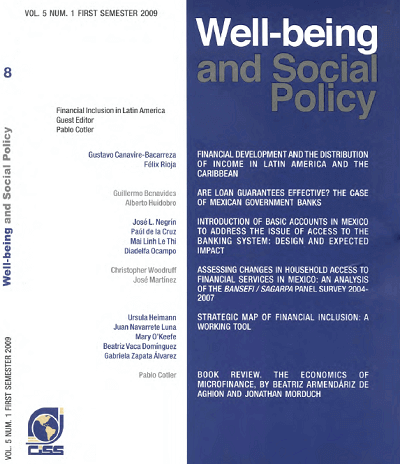
|
|
|
|

|
|
An investigation into the cost of universal health coverage in Mexico
The Mexican social security system, after operating for over six decades, has managed to provide healthcare for slightly over half the resident population.
There are wide geographical and socioeconomic variations in coverage. To provide wider coverage, the Federal Government created the Sistema de Protección Social en Salud (SPSS) for covering low income family. It becomes the third...
|

|
|
|
|

|
|
Book review. Public policy for an inclusive growth, edited by Pablo Cotler
The book “Public Policy for an Inclusive Growth” (The book) is an opportune and fortunate document. It is opportune because it is presented at a time in which public policy topics are subject to a wide debate in Mexico, and the discussion is fed with diverse points of view, theoretical and political, from which it is the purpose to analyze, design, redesign, implement, and evaluate the government...
|
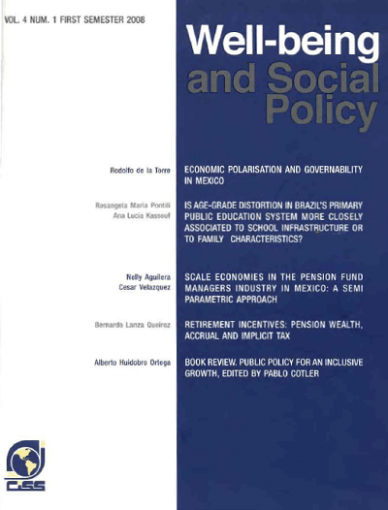
|
|
|
|

|
|
Scale economies in the pension fund managers industry in Mexico: a semi parametric approach
It has been widely accepted that reforms on pension schemes have led to improvements in the financial viability of the systems. Nevertheless, at the same time it has been shown that fees charged by pension fund managers (PFM) are very high, implying high mark-ups for them and lower expected pensions for the participants. The presence of economies of scale has been suggested as one main reason for...
|
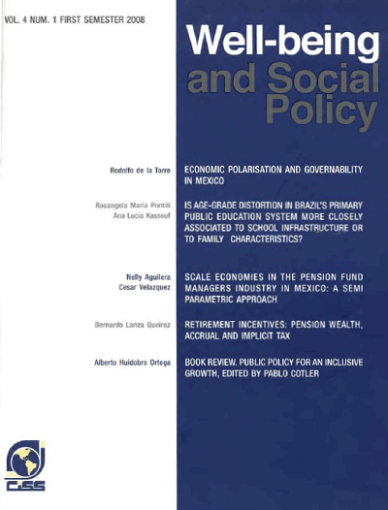
|
|
|
|

|
|
Economic polarisation and gobernality in México
The purpose of this essay is to appraise alternative hypothesis about the origins of recent social revolt in Mexico. It shows that it is not clear that a severe rise in poverty preceded the origins of violent conflict but social polarisation. Therefore, government attempts to deactivate the economic factors that led to social unrest did not necessarily upgrade povertyreduction policies. The...
|

|
|
|
|

|
|
Conflict and power: the teachers' union and education quality in Mexico
The teachers union in Mexico, or Sindicato Nacional de Trabajadores de la Educación (SNTE) represents over 1 million members and is the largest in Latin America. This study uses data from the national student tests administered by the Instituto Nacional para la Evaluación de la Educación (INEE), along with data from the Mexican Ministry of Education and other sources, to investigate the...
|
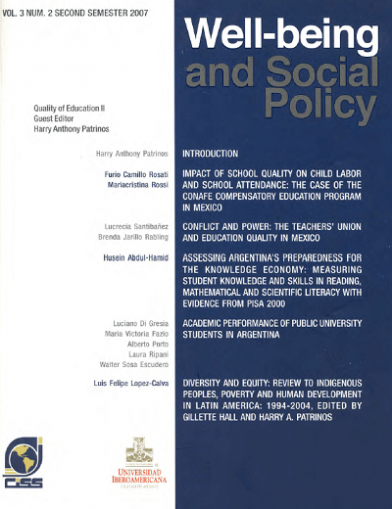
|
|
|
|

|
|
Impact of school quality on child labor and school attendance: the case of the CONAFE compensatory education program in Mexico
This paper focuses on the impact that two different types of policy interventions, namely enhancing school quality and contingent cash transfers, have on child labor and school attendance in Mexico. While there are many studies on the impact of Oportunidades on schooling outcomes, little evidence is available on whether school quality programs such as CONAFE also reduce child labor and help keep...
|

|
|
|
|

|
|
Book review. Improving the quality of education in Mexico: Positions and proposals, edited by Francisco Miranda, Harry Patrinos y Ángel López
This book gathers analyses performed by several authors on policies considered appropriate by the World Bank to enhance the quality of basic education provided in Mexico, in particular, education received by majority sectors in our society (World Bank: 2005).
|

|
|
|
|

|
|
Institutional effects as determinants of leaning outcomes: exploring state variations in Mexico
We use the PISA 2003 student-level achievement database for Mexico to estimate state education production functions. Student characteristics, family background, home inputs, resources and institutions are controlled for. We take advantage of the state-level variation and representative sample to analyze the impact of institutional factors such as state accountability systems and the role of...
|

|
|
|
|

|
|
Workers' remittances and currency crises
We seek to further understand the factors that determine per emigrant remittances using data from 23 Latin American and Caribbean countries over the 1980-2003 period. We find that emigrants avoid remitting when the exchange rate is under pressure. This finding is consistent with the notion that remitters strive to reduce their exposure to exchange rate losses by taking into account the expected...
|
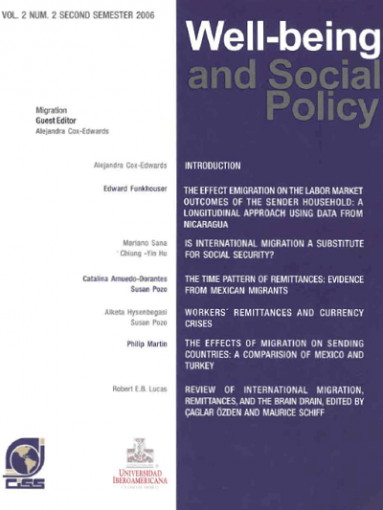
|
|
|
|

|
|
The time pattern of remittances: evidence from mexican migrants
We explore the time pattern of remittances using data on return migrants from the Mexican Migration Project. Some of these return migrants have settled in the U.S. and are returning to Mexico to visit family and friends, whereas others are temporary migrants returning home after a working spell in the U.S. We find that the dollar amount remitted first increases with time spent in the U.S. to...
|
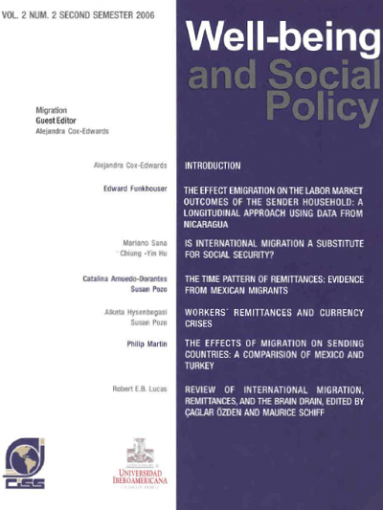
|
|
|
|

|
|
Public spaces in Mexico as social cohesion promoters: an structural modeling perspective
This research assessed the effects of several contextual factors (e.g, neighborhood insecurity, evaluation of public spaces, infrastructure, low risk behaviors) on social cohesion and residential satisfaction, in the context of low and medium-low socio economic status of individuals nearby renovated public spaces (parks and recreational facilities) in Mexico. The research method is based on...
|

|
|
|
|
|